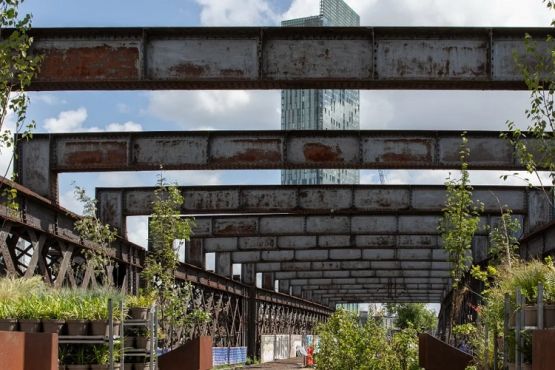The excitement of seeing Manchester’s new Sky Park spring to life

Through the work of our fundraising team, a new urban sky park on Manchester’s Castlefield Viaduct is springing into life with thousands of plants being added to the derelict structure. Find out why it’s important and how it could help shape the future of the area.
National Trust gardening specialists and apprentices have been planting 3,000 trees, flowers and shrubs on the viaduct as part of plans to ‘green’ the historic landmark and bring more nature to the Castlefield area of the city.
Opened to the public in July, the Trust aims to turn the viaduct into a temporary urban park and capture visitors’ opinions to help determine the longer-term future of the Grade II listed structure. You can experience a variety of planting displays as you walk along the viaduct, moving through an area of native plants, shrubs and trees, to a ‘show garden’ setting at the end.
In addition to creating a place where people and nature meet, the new experience will also celebrate the industrial heritage of Castlefield. The design of the planters gives a subtle nod to the industrial architecture of the viaduct, which was built in 1892 by Heenan and Froude, the engineers who worked on Blackpool Tower. The shape of the planters mirrors the curve of the viaduct, and their width is the same as the railway tracks that once transported goods across the structure to the Great Northern Warehouse. A section of the viaduct will be left untouched to provide a sense of how nature has reclaimed the space since the site closed in the late 1960s.
Plants take inspiration from what had already started to grow on the viaduct with shrubs, ferns and grasses providing a frame for more colourful seasonal planting. Sections of the planting will mimic the diamond shape of the viaduct’s criss-cross steelwork and the original ballast surface is incorporated into the scheme with 280 sandbags built up at varying heights to create planters.
A canopy is also being created using 600 half-hardy annual climbers and others including hops and clematis which will tumble down. Many of the plants have been grown at the National Trust’s Plant Conservation Centre, with others coming from nearby Trust property, Dunham Massey.
Pamela Smith, Senior National Consultant for Gardens & Parklands at the National Trust said “We’ve reached an exciting stage in the project to transform Castlefield Viaduct into a green space for the people of Manchester. Creating a garden on an industrial heritage structure such as this is untested territory for us, and we’re intrigued to see how the plant life will take to its new surroundings.”
Amy Watson, Castlefield Gardener at the National Trust said “Castlefield Viaduct is unlike any other garden in the National Trust’s care, and we’ll be keeping a close eye on the garden to see how it gets on over the next 12 months. I’ll be working with a team of dedicated volunteers and apprentices to plant bulbs on a regular basis, and adding to the planting to make sure there’s plenty to see throughout the year. We’ll also be working closely with our partners to see how their gardens are responding to their unique surroundings.”
Four areas of the viaduct have been handed over to partner organisations to create their own unique gardens for visitors to enjoy. Known as ‘partner plots’ these areas by Urban Wilderness, the Science and Industry Museum, City of Trees and Castlefield Forum are in the final stages of completion.
Sophie Wardell, Urban Places Programme Manager at the National Trust said “So much hard work has gone into getting the viaduct to this point and we couldn’t have got this far without the support of our partners and those who have helped make this happen for Manchester. A little over 12 months ago we’d only just shared the artist illustrations of what the viaduct could look like, and now it’s becoming a reality. This first year is an experiment for us to see what people want Castlefield Viaduct to be in the future and we’re excited to hear what ideas they have.”
Costing £1.8 million, the pilot has been made possible thanks to funding raised by players of People’s Postcode Lottery, as well as public donations which will cover two-thirds of the build costs.
The plans for Castlefield Viaduct are part of the National Trust’s Urban Places work to increase access to parks and green spaces in, around, and near urban areas, so that more people are in easy reach of quiet places with wide open skies.
The National Trust will also need to raise funds to support the future of Castlefield Viaduct, and you could be part of the team making it happen.
Categories
- Apprenticeships (52)
- Building Surveying (3)
- Business Services (1)
- Catering (1)
- Communications and Marketing (3)
- Conservation (9)
- Countryside (10)
- Curatorship (3)
- Diversity (1)
- Estate Management (4)
- Finance (2)
- Food and Beverage (6)
- Fundraising (8)
- Gardening (11)
- General Management (2)
- Governance (2)
- Heritage Building Crafts (4)
- Holidays (3)
- House and Collections (4)
- IT (8)
- Membership (1)
- People and Legal (3)
- Projects and Programmes (6)
- Retail (2)
- This is us (5)
- Visitor Experience (3)
- Volunteer and Community (3)
- Volunteering (1)
- Work Experience (1)
- Young People (12)

